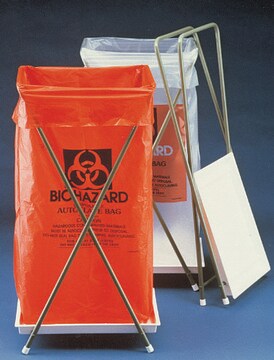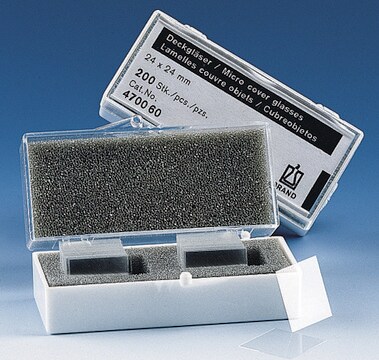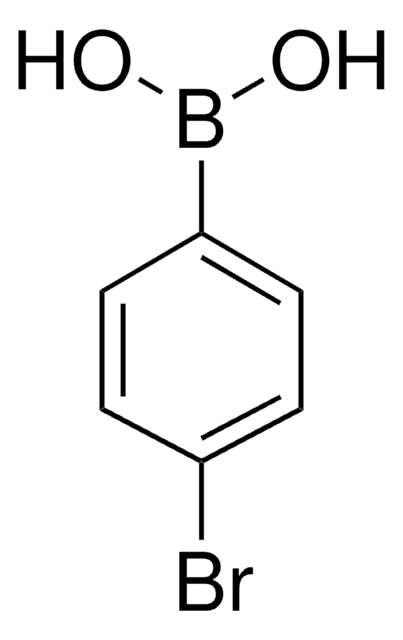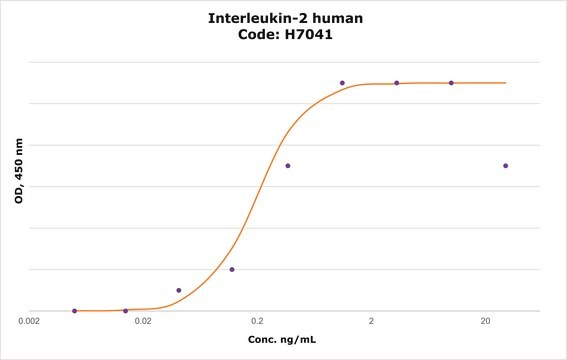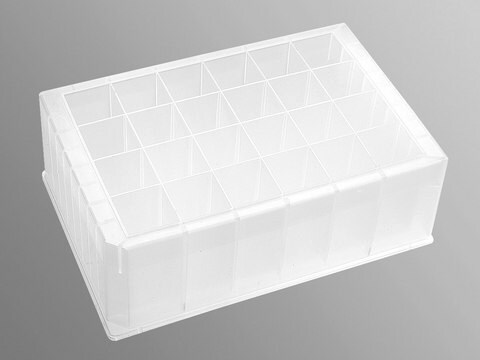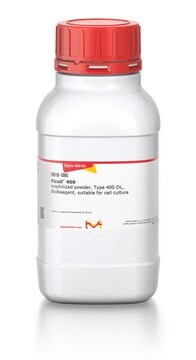推荐产品
生物源
human peripheral blood
形狀
solid
包裝
pkg of 10,000,000 cells (HMNC-PB)
製造商/商標名
Cell Applications, Inc
增長模式
Suspension
染色體組型
2n = 46
形態學
mononuclear
技術
cell culture | mammalian: suitable
相關疾病
acquired immunodeficiency syndrome/human immunodeficiency virus (AIDS/HIV); infectious diseases; autoimmune diseases
運輸包裝
dry ice
儲存溫度
−196°C
一般說明
Lot specific orders are not able to be placed through the web. Contact your local sales rep for more details.
The leukocytes can be divided into two groups: mononuclear and granulocytic cells. The mononuclear cells mainly consist of lymphocytes and monocytes. The lymphocyte population consists of T cells (CD4 and CD8 positive ~75%), B cells and NK cells (~25% combined). In contrast to the granulocytes, these cells have rounded nuclei, some with indentations or folds. The mononuclear cells are involved in various ways with the body′s defense mechanisms.
1. These cells are critical components in the immune system to fight bacterial, viral infections, and function as immune surveillance network to kill tumor cells. The mononuclear cells also secrete a great variety of cytokines to regulate immune response as well as inflammation. Moreover, it has been demonstrated that the mononuclear cells may mediate various biological effects on other tissue and organs. For example, the chemokines produced by monocytes can act on adipocytes and muscles. Human Mononuclear Cells (HMNC) are often extracted from from bone marrow (BM) or peripheral blood (PB) using Ficoll-Hypaque density gradient centrifugation, a hydrophilic polysaccharide that separates layers of blood, with mononuclear cells forming a buffy coat under a layer of plasma. Generally, this buffy coat mainly contains lymphocytes and monocytes, other cell types such as cells are detected in Human Mononuclear Cell (HMNC) preparation.
2. Human Mononuclear Cells (HMNC) are widely used in research and clinical applications every day. The HMNCs are important tool for various studies in the fields of immunology (including auto-immune disorders), infectious disease, hematological malignancies, vaccine development, transplant immunology, and high-throughput screening.
3. HIV research uses them because PBMCs include CD4+ cells, which are the cells HIV infects.
4. Moreover, HMNCs have been accepted as a unique material for cancer immunotheurapy using dendritic cells or activated lymphocytes as an alternative or adjuvant to conventional therapies such as surgery, chemotherapy and radiation treatment.
5,6. Endothelial progenitor cells derived from HMNC have been used in neovascularization to improve limb ischemia
7. In cell therapy to repair ischemic and infracted myocardium.
8. Human Mononuclear Cells (HMNC) should provide a useful tool for studying various aspects of pathology and biology of the human mononuclear cells in vitro.
Human Mononuclear Cells (HMNC) are derived from human peripheral blood (HMNC-PB) using Ficoll-Hypaque density gradient centrifugation. They are cryopreserved immediately after isolation.
1. Allison, A.C. et al, Annu. Rev. Immunol. 1:361 (1983); 2. Sales, V.L. et al, Tissue Eng. 13:525 (2007); 3. Juranic, Z. et al, J. Exp. Clin. Cancer Res. 18:317 (1999); 4. Vicenzi E. et al, J. Leukoc. Biol. 68:405 (2000); 5. Steinman, R. M. et al, Int. J. Cancer 94:459 (2001); 6. Schuler, G., Cancer Immunity 3 (Suppl 1):23 (2003); 7. Kalka, C. et al, Proc. Natl. Acad. Sci. USA 97:3422 (2000); 8. Masuda, H. et al, Cardiovasc. Res. 58:390 (2003)
The leukocytes can be divided into two groups: mononuclear and granulocytic cells. The mononuclear cells mainly consist of lymphocytes and monocytes. The lymphocyte population consists of T cells (CD4 and CD8 positive ~75%), B cells and NK cells (~25% combined). In contrast to the granulocytes, these cells have rounded nuclei, some with indentations or folds. The mononuclear cells are involved in various ways with the body′s defense mechanisms.
1. These cells are critical components in the immune system to fight bacterial, viral infections, and function as immune surveillance network to kill tumor cells. The mononuclear cells also secrete a great variety of cytokines to regulate immune response as well as inflammation. Moreover, it has been demonstrated that the mononuclear cells may mediate various biological effects on other tissue and organs. For example, the chemokines produced by monocytes can act on adipocytes and muscles. Human Mononuclear Cells (HMNC) are often extracted from from bone marrow (BM) or peripheral blood (PB) using Ficoll-Hypaque density gradient centrifugation, a hydrophilic polysaccharide that separates layers of blood, with mononuclear cells forming a buffy coat under a layer of plasma. Generally, this buffy coat mainly contains lymphocytes and monocytes, other cell types such as cells are detected in Human Mononuclear Cell (HMNC) preparation.
2. Human Mononuclear Cells (HMNC) are widely used in research and clinical applications every day. The HMNCs are important tool for various studies in the fields of immunology (including auto-immune disorders), infectious disease, hematological malignancies, vaccine development, transplant immunology, and high-throughput screening.
3. HIV research uses them because PBMCs include CD4+ cells, which are the cells HIV infects.
4. Moreover, HMNCs have been accepted as a unique material for cancer immunotheurapy using dendritic cells or activated lymphocytes as an alternative or adjuvant to conventional therapies such as surgery, chemotherapy and radiation treatment.
5,6. Endothelial progenitor cells derived from HMNC have been used in neovascularization to improve limb ischemia
7. In cell therapy to repair ischemic and infracted myocardium.
8. Human Mononuclear Cells (HMNC) should provide a useful tool for studying various aspects of pathology and biology of the human mononuclear cells in vitro.
Human Mononuclear Cells (HMNC) are derived from human peripheral blood (HMNC-PB) using Ficoll-Hypaque density gradient centrifugation. They are cryopreserved immediately after isolation.
1. Allison, A.C. et al, Annu. Rev. Immunol. 1:361 (1983); 2. Sales, V.L. et al, Tissue Eng. 13:525 (2007); 3. Juranic, Z. et al, J. Exp. Clin. Cancer Res. 18:317 (1999); 4. Vicenzi E. et al, J. Leukoc. Biol. 68:405 (2000); 5. Steinman, R. M. et al, Int. J. Cancer 94:459 (2001); 6. Schuler, G., Cancer Immunity 3 (Suppl 1):23 (2003); 7. Kalka, C. et al, Proc. Natl. Acad. Sci. USA 97:3422 (2000); 8. Masuda, H. et al, Cardiovasc. Res. 58:390 (2003)
細胞系來源
Human Peripheral Blood
應用
immune surveillance and defense, cytokine and chemokine production, immunoregulation, research, clinical applications, vaccine development, transplant immunology, high-throughput screening, HIV research, cancer immunotherapy, infection fighting, study of T, B and NK cells,
成分
HMNC-PB in DMEM containing 45% FBS & 10% DMSO
準備報告
- Immediately after isolation, 10,000,000 HMNC-PB in DMEM containing 45% FBS & 10% DMSO
- Blood cells do not proliferate in culture
例行更新培養
Please refer to the HMNC-PB Culture Protocol.
免責聲明
RESEARCH USE ONLY. This product is regulated in France when intended to be used for scientific purposes, including for import and export activities (Article L 1211-1 paragraph 2 of the Public Health Code). The purchaser (i.e. enduser) is required to obtain an import authorization from the France Ministry of Research referred in the Article L1245-5-1 II. of Public Health Code. By ordering this product, you are confirming that you have obtained the proper import authorization.
儲存類別代碼
11 - Combustible Solids
水污染物質分類(WGK)
WGK 3
閃點(°F)
Not applicable
閃點(°C)
Not applicable
其他客户在看
Nilesh P Gawas et al.
Oncology reports, 41(4), 2289-2298 (2019-03-01)
Oral squamous cell carcinoma (OSCC) is a leading cause of mortality in India owing to the high percentage of tobacco chewers, smokers and alcohol consumption. OSCC is highly heterogeneous in nature; therefore poses a challenge in the treatment of the
Nilesh P Gawas et al.
Oncology reports, 41(4), 2289-2298 (2019-03-01)
Oral squamous cell carcinoma (OSCC) is a leading cause of mortality in India owing to the high percentage of tobacco chewers, smokers and alcohol consumption. OSCC is highly heterogeneous in nature; therefore poses a challenge in the treatment of the
实验方案
Technical information for working with human mononuclear cells – periphery blood including thawing, subculturing and cryopreservation
我们的科学家团队拥有各种研究领域经验,包括生命科学、材料科学、化学合成、色谱、分析及许多其他领域.
联系技术服务部门


